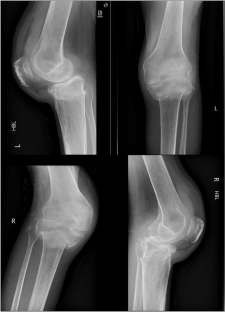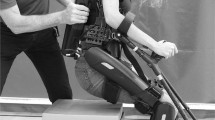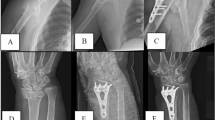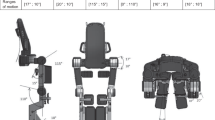Abstract
Introduction
Powered robotic exoskeleton (PRE) physiotherapy programmes are a relatively novel frontier which allow patients with reduced mobility to engage in supported walking. Research is ongoing regarding their utility, risks, and benefits. This article describes the case of two fractures occurring in one patient using a PRE.
Case
We report the case of a 54 year old man who sustained bilateral tibial fractures while using a PRE, on a background of T10 AIS A SCI. The initial session was discontinued due to acute severe bilateral knee swelling after approximately 15 min. The patient attended their local hospital the following day, where radiographs demonstrated bilateral proximal tibial fractures. The patient was treated with manipulation under anaesthetic and long-leg casting for five weeks, at which point he was stepped down to hinged knee braces which were weaned gradually while he remained non-weight bearing for 12 weeks. The patient was investigated with DEXA scan and was diagnosed with osteoporosis. He was liaised with rheumatology services and bone protection was initiated. Fracture healing was achieved and weight-bearing precautions were discontinued, however this period of immobilisation led to significant spasticity. The patient was discharged from orthopaedic services, with ongoing rehabilitation and physiotherapy follow-up.
Conclusion
PRE assisted physiotherapy programmes are a promising concept in terms of rehabilitation and independence, however they are not without risk and it is important that both providers and patients are aware of this. Furthermore, SCI patients are at increased risk for osteoporosis and should be monitored and considered for bone protection.
This is a preview of subscription content, access via your institution
Access options
Subscribe to this journal
Receive 1 print issues and online access
We are sorry, but there is no personal subscription option available for your country.
Buy this article
- Purchase on Springer Link
- Instant access to full article PDF
Prices may be subject to local taxes which are calculated during checkout




Similar content being viewed by others
Data availability
Information generated and analysed during the writing of this paper can be found within the text itself and referenced articles.
References
Bao G, Pan L, Fang H, Wu X, Yu H, Cai S, et al. Academic review and perspectives on robotic exoskeletons. IEEE Trans Neural Syst Rehabil Eng. 2019;27:2294–304.
Karelis AD, Carvalho LP, Castillo MJ, Gagnon DH, Aubertin-Leheudre M. Effect on body composition and bone mineral density of walking with a robotic exoskeleton in adults with chronic spinal cord injury. J Rehabil Med. 2017;49:84–7.
Gorgey AS, Dolbow DR, Dolbow JD, Khalil RK, Castillo C, Gater DR. Effects of spinal cord injury on body composition and metabolic profile - part I. J Spinal Cord Med. 2014;37:693–702.
Abdelrahman S, Ireland A, Winter EM, Purcell M, Coupaud S. Osteoporosis after spinal cord injury: Aetiology, effects and therapeutic approaches. J Musculoskelet Neuronal Interact. 2021;21:26–50.
Ma Y, de Groot S, Romviel S, Achterberg W, van Orsouw L, Janssen TWJ. Changes in body composition during and after inpatient rehabilitation in people with recent spinal cord injury. Spinal Cord Ser Cases. 2021;7:88.
Asselin P, Cirnigliaro CM, Kornfeld S, Knezevic S, Lackow R, Elliott M, et al. Effect of exoskeletal-assisted walking on soft tissue body composition in persons with spinal cord injury. Arch Phys Med Rehabil. 2021;102:196–202.
Morse L. Osteoporosis prophylaxis in acute SCI. Spinal Cord Ser Cases. 2019;5:27.
Shackleton C, Evans R, West S, Derman W, Albertus Y. Robotic walking to mitigate bone mineral density decline and adverse body composition in individuals with incomplete spinal cord injury: a pilot randomized clinical trial. Am J Phys Med Rehabil. 2022;101:931–6.
Zleik N, Weaver F, Harmon RL, Le B, Radhakrishnan R, Jirau-Rosaly WD, et al. Prevention and management of osteoporosis and osteoporotic fractures in persons with a spinal cord injury or disorder: A systematic scoping review. J Spinal Cord Med. 2019;42:735–59.
Kim HS, Park JH, Lee HS, Lee JY, Jung JW, Park SB, et al. Effects of wearable powered exoskeletal training on functional mobility, physiological health and quality of life in non-ambulatory spinal cord injury patients. J Korean Med Sci. 2021;36:1–15.
Miller LE, Zimmermann AK, Herbert WG. Clinical effectiveness and safety of powered exoskeleton-assisted walking in patients with spinal cord injury: systematic review with meta-analysis. Med Dev. 2016;9:455–66.
Rodriguez Tapia G, Doumas I, Lejeune T, Previnaire JG. Wearable powered exoskeletons for gait training in tetraplegia: a systematic review on feasibility, safety and potential health benefits. Acta Neurol Belg. 2022;122:1149–62.
Tamburella F, Lorusso M, Tramontano M, Fadlun S, Masciullo M, Scivoletto G. Overground robotic training effects on walking and secondary health conditions in individuals with spinal cord injury: systematic review. J Neuroeng Rehabil. 2022;19:27.
van Herpen FHM, van Dijsseldonk RB, Rijken H, Keijsers NLW, Louwerens JWK, van Nes IJW. Case Report: Description of two fractures during the use of a powered exoskeleton. Spinal Cord Ser Cases. 2019;5:99.
Bass A, Morin SN, Vermette M, Aubertin-Leheudre M, Gagnon DH. Incidental bilateral calcaneal fractures following overground walking with a wearable robotic exoskeleton in a wheelchair user with a chronic spinal cord injury: is zero risk possible? Osteoporos Int. 2020;31:1007–11.
Benson I, Hart K, Tussler D, Van Middendorp JJ. Lower-limb exoskeletons for individuals with chronic spinal cord injury: Findings from a feasibility study. Clin Rehabil. 2016;30:73–84.
Galen SS, Clarke CJ, McLean AN, Allan DB, Conway BA. Isometric hip and knee torque measurements as an outcome measure in robot assisted gait training. NeuroRehabilitation. 2014;34:287–95.
Tow A, Lim WS, Sew S. Rehabilitation outcomes of robotic-assisted locomotor training in incomplete spinal cord injured individuals. Top Spinal Cord Inj Rehabil 2011;16:109.
Thoumie P, Le Claire G, Beillot J, Dassonville J, Chevalier T, Perrouin-Verbe B, et al. Restoration of functional gait in paraplegic patients with the RGO-II hybrid orthosis. A multicenter controlled study. II: Physiological evaluation. Paraplegia 1995;33:654–9.
van Dijsseldonk RB, van Nes IJW, Geurts ACH, Keijsers NLW. Exoskeleton home and community use in people with complete spinal cord injury. Sci Rep. 2020;10:15600.
Spungen AM, Asselin PK. Indications and contraindications for exoskeletal-assisted walking in persons with spinal cord injury using evidence-based data. PM R 2020;12:S41.
Bass A, Aubertin-Leheudre M, Morin SN, Gagnon DH. Preliminary training volume and progression algorithm to tackle fragility fracture risk during exoskeleton-assisted overground walking in individuals with a chronic spinal cord injury. Spinal Cord Ser Cases. 2022;8:29.
Bessler J, Schaake L, Kelder R, Buurke JH, Prange-Lasonder GB. Prototype Measuring Device for Assessing Interaction Forces between Human Limbs and Rehabilitation Robots - A Proof of Concept Study. In: Proceedings of the 2019 IEEE 16th International Conference on Rehabilitation Robotics (ICORR); 2019; Toronto, ON, Canada. Piscataway, NJ: IEEE; 2019 [cited 2023 Sep 5]. p. 1109–1114. Available from: https://ieeexplore.ieee.org/document/8779536
Bessler-Etten J, Schaake L, Prange-Lasonder GB, Buurke JH. Assessing effects of exoskeleton misalignment on knee joint load during swing using an instrumented leg simulator. J Neuroeng Rehabil. 2022;19:13.
Wan X, Liu Y, Akiyama Y, Yamada Y. Monitoring contact behavior during assisted walking with a lower limb exoskeleton. IEEE Trans Neural Syst Rehabil Eng. 2020;28:869–77.
Xiang XN, Ding MF, Zong HY, Liu Y, Cheng H, He CQ, et al. The safety and feasibility of a new rehabilitation robotic exoskeleton for assisting individuals with lower extremity motor complete lesions following spinal cord injury (SCI): an observational study. Spinal Cord. 2020;58:787–94.
Gagnon DH, Escalona MJ, Vermette M, Carvalho LP, Karelis AD, Duclos C, et al. Locomotor training using an overground robotic exoskeleton in long-term manual wheelchair users with a chronic spinal cord injury living in the community: Lessons learned from a feasibility study in terms of recruitment, attendance, learnability, performance and safety. J Neuroeng Rehabil. 2018;15:12.
Acknowledgements
The authors would like to acknowledge the contributions of Dr. Cara McDonagh and her team in the National Rehabilitation Hospital, and Dr. Kieran Kelliher of Turloughmore Medical Centre for their ongoing care of the patient in this case. We would also like to acknowledge the staff at the Dublin City University Exoskeleton Programme for their assistance and expertise in the subject matter.
Funding
This project did not receive any specific grant from funding agencies in the public, commercial, or not-for-profit sectors.
Author information
Authors and Affiliations
Contributions
JM was the main author, and was responsible for data collection and liaison with the patient, review of the literature, and writing the manuscript. LN contributed to review of the literature, data collection, and contributed to writing the manuscript. DOS and MC were involved in initial literature search, and contributed to review and feedback on the manuscript. AD and CGM are senior authors who provided feedback and final approval of the manuscript.
Corresponding author
Ethics declarations
Competing interests
The authors declare no competing interests.
Ethical approval
Ethical approval was not required for this project given that it was a case report concerning one patient, whose informed consent was obtained for production and publication of the manuscript.
Informed consent
The authors confirm that the patient is aware that data concerning his case would be submitted for publication and proceed with his informed consent.
Additional information
Publisher’s note Springer Nature remains neutral with regard to jurisdictional claims in published maps and institutional affiliations.
Rights and permissions
Springer Nature or its licensor (e.g. a society or other partner) holds exclusive rights to this article under a publishing agreement with the author(s) or other rightsholder(s); author self-archiving of the accepted manuscript version of this article is solely governed by the terms of such publishing agreement and applicable law.
About this article
Cite this article
Mahon, J., Nolan, L., O’Sullivan, D. et al. Bilateral tibial fractures associated with powered exoskeleton use in complete spinal cord injury – a case report & literature review. Spinal Cord Ser Cases 10, 22 (2024). https://doi.org/10.1038/s41394-024-00635-4
Received:
Revised:
Accepted:
Published:
DOI: https://doi.org/10.1038/s41394-024-00635-4



